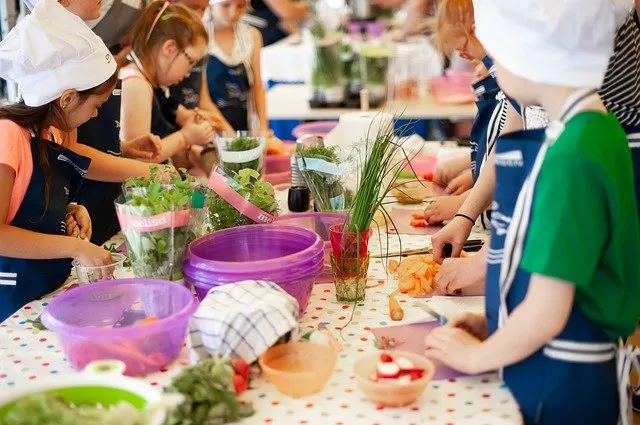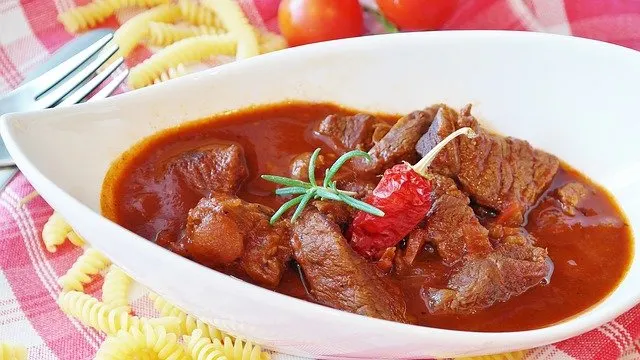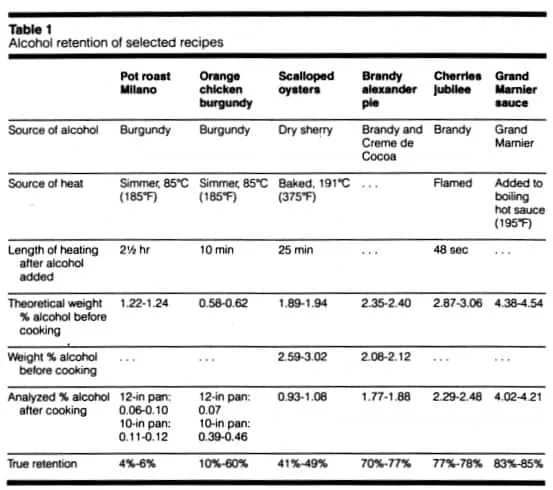I have a toddler who loves to eat, and I do occasionally make recipes that call for wine to be cooked with the food. So I’ve wondered can toddlers eat food cooked in wine?
Food that has been cooked with wine (or beer) for 90 minutes or more is perfectly safe to give to toddlers. Contrary to popular belief, all alcohol does not cook off when cooked and some methods leave up to 85% of the alcohol remaining. But avoid giving young children food cooked with liquor.
But there’s a great deal more to know about cooking with wine (or beer) and does the alcohol cook out. So we’ll explore if it cooks out and if so, how long and high of a temp that takes.
I’ll also take a look at whether there’s any difference between white and red wine and cooking wine, what the most appropriate cooking methods for making sure the alcohol dissipates, and we’ll talk about some non-alcoholic substitutes if you prefer to go that route.
That way, you can rest easy knowing your kids aren’t accidentally ingesting alcohol.
Let’s get going!
Table of Contents:
- Does wine cook out of food?
- How long should you boil wine to remove the alcohol?
- Can you use wine as a basting liquid when feeding kids?
- Can toddlers eat food cooked in beer?
- Can young kids or babies eat food with wine in it?
- Tips on evaporating alcohol from foods when cooking
- What are the effects on children from meals cooked with alcohol?
- Frequently Asked Questions
- Conclusion

Does wine cook out of food?
Not fully is the short answer.
Most of us, myself included have long heard the urban myth that cooking removes alcohol. Most people have never questioned that either.
But it’s not really accurate. Traces of alcohol do remain by the end of the cooking process.
Back in the ’90s, the Nutrient Data Lab, which is part of the U.S. Department of Agriculture conducted a study titled “Alcohol retention in food preparation”.
In that study, they used 6 different recipes and cooking methods to test the theory. As you can see in their chart, some recipes like pot roast only had 4-6% of the alcohol left when serving.
But a Grand Marnier sauce, by comparison, which had the alcohol added to the sauce mix at 195° degrees, retained up to 85% of the alcohol; not what you want for your toddler!
So how much alcohol remains? Check out their handy chart.
So what accounts for the differences in alcohol retention?
The study found that the type of heat used made all the difference. Simmering seemed to produce the best results. So if you’re making a fancy dinner with a wine reduction sauce or pasta sauce that has been simmered for hours, you’re likely going to be just fine.
Pot roast is a great example of that having been simmered for 2 1/2 hours.
The oysters, on the other hand, were baked a higher temperature, but for far less time with much less direct heat. So it makes sense that they still retained almost half the alcohol of when the dish started cooking.
But as the study concludes, “the assumption that all alcohol is evaporated when heat is applied during cooking is not valid.”
The factors they found that influence alcohol cooking off the most include:
- Type of heat source
- Lighting the alcohol on fire results in much smaller alcohol loss
- The type of cooking vessel (pot, pan, etc) can also affect alcohol loss
- An alcoholic beverage with a higher alcohol content
So if you are cooking with alcohol and planning on feeding it to your toddler or other kids, pay close attention to those things! Some alcohol cooks out, but certainly not all. And in some cases, a large percentage of it remains.
How long should you boil wine to remove the alcohol?
As a general rule, when boiling regular wine on the stovetop, it takes about 30 minutes for the alcohol to cook off.
Alcohol boils at a lower temperature than water. The boiling point of alcohol is 186.8°, compared to water which boils at 212°. Technically, products can be considered non-alcoholic when the alcohol content reaches .5%. So how long does that take?
Well as we learned in the above section, that depends on the heat source, cooking time, and a few other factors.
This handy chart courtesy of the US Department of Agriculture may help in getting you some answers though for other cooking methods and how much alcohol remains:
|
Alcohol Burn-off Chart – US Dept of Agriculture
|
|
| Preparation Method | Percent Retained |
| alcohol added to boiling liquid & removed from heat | 85% |
| alcohol flamed | 75% |
| no heat, stored overnight | 70% |
| baked, 25 minutes, alcohol not stirred into mixture | 45% |
| Baked/simmered dishes with alcohol stirred into mixture: | |
| 15 minutes cooking time | 40% |
| 30 minutes cooking time | 35% |
| 1 hour cooking time | 25% |
| 1.5 hours cooking time | 20% |
| 2 hours cooking time | 10% |
| 2.5 hours cooking time | 5% |
To be totally safe when cooking foods with wine, have the end of the cooking time be at least 2 hours. Make sure to add the wine at the start of that to ensure only a trace of alcohol remains by the end of cooking.
Thinking about a Crock-Pot?
The slow cooker’s lower temperatures mean it will take a LOT longer for alcohol to burn off. Plus when you have the lid locked, there’s nowhere for that steam (which will have a trace of alcohol) to go.
So personally, I would only do this in a slow cooker if I was doing something like chili overnight for several hours and not using that much alcohol to begin with.
Can you use wine as a basting liquid when feeding kids?
Basting is when you pour a liquid over meat while it is cooking. So an example might be pouring small amounts of white wine, every 15 minutes, on a whole chicken you are roasting in the oven.
Since this is largely running off the food and into the pan, as long as you stop doing that for the last hour of cooking, you will be just fine.
And if you make a reduction sauce from the juices in the pan, it is probably best to not give that to your toddler.

Can toddlers eat food cooked in beer?
The most common thing might be beer cheese soup or chili, both of which I have made and added beer to.
We know from the sections above that slow simmering of alcohol in a larger pot of skillet produces the best results in terms of cooking off alcohol. Beer also only has 14 grams of alcohol per a 12-fluid-ounce can or bottle.
Now, I fully admit I’ve given my young kids chili I’ve made with a can of beer in it. I’ve also used a little beer in some batters for deep frying too. And when I make risotto, I always use some wine in addition to chicken broth.
I was still operating then under the assumption that cooking removes the alcohol, which we now know as false.
And nothing bad happened (at least as far as the alcohol goes).
But for maximum safety for your kids, simmer food on the stovetop for at least 30 minutes if not 1 or more hours and use the least amount of alcohol possible for your recipe.

Can young kids or babies eat food with wine in it?
It’s best not to give babies or toddlers any food that’s been cooked with liquor. But generally speaking, beer or wine can be ok. But again, the cooking method varies greatly in terms of how much less alcohol remains in the food when it’s time to eat.
The longer you cook food that you’ve added alcohol to, the lower the percentage of alcohol remaining when you serve it.
For example, soups, or sauces with wine or beer for simmered for 90 minutes or more will see most of the alcohol cooked off.
A small amount of alcohol may still be present, but it’s likely going to be well under the .5% classification for non-alcoholic. The higher the burner on your simmer, the faster the alcohol will evaporate.
Whatever alcohol that’s still present is not likely to cause harm to anyone, including babies. But of course, if you want to be 100% sure, avoid giving babies or toddlers anything cooked with alcohol.
But I’ve followed those steps with my 3 kids without any issues whatsoever.
However, it’s worth pointing out that if you add alcohol later in the cooking process a much higher amount of alcohol will remain in the finished dish.
That’s especially true if you just add the alcohol to hot food or liquid and then remove it from the heat. And it’s even truer for a hot dish where you are flambéeing or lighting the alcohol on fire.
While that might look like it’s literally burning up the alcohol, your finished dish might actually have up to 75% of the alcohol still in the dish.
Tips on evaporating alcohol from foods when cooking
Alcohol is a common ingredient in many dishes, but sometimes it’s necessary to remove it. Whether you’re cooking for someone who doesn’t drink alcohol or simply trying to reduce the alcohol content of your dish, there are a few tips and tricks you can use to evaporate alcohol from foods while cooking.
1. Wait for the alcohol to evaporate naturally
If you’re cooking a dish that requires simmering or braising, the alcohol will naturally evaporate over time as the liquid reduces. This can take anywhere from a few minutes to a few hours depending on the dish, but it’s the easiest and most foolproof way to remove alcohol.
2. Use high heat to speed up evaporation
If you’re short on time, you can use high heat to speed up the evaporation process. This is especially useful if you’re cooking with wine or another liquid that has a low alcohol content. Simply turn up the heat and let the liquid simmer until the alcohol has evaporated.
3. Add water or other liquids to dilute the alcohol
Adding water or other liquids to your dish can help dilute the alcohol and reduce the overall alcohol content. This is a good option if you want to retain the flavor of the alcohol but need to reduce the amount of alcohol in the dish.
4. Use a lid to trap the alcohol vapor
When cooking with alcohol, a lot of the alcohol will evaporate into the air. You can trap some of this alcohol vapor by using a lid on your cooking vessel. This can help to retain the flavor of the alcohol while reducing the overall alcohol content of the dish.
5. Flame the alcohol to burn it off
If you’re using a high-proof alcohol like vodka or rum, you can flame the alcohol to burn it off. To do this, heat the alcohol in a pan until it begins to vaporize, then carefully ignite the vapors with a long match or lighter. The flames will burn off the alcohol, leaving behind the flavor of the alcohol without the alcohol content.
6. Stir it often
Stirring your dish often helps to aerate the dish and ensures that all of the alcohol gets thoroughly mixed in as that all of it comes into close contact with the heat coming from under the pan.
7. Use a large skillet or wide pot
A larger surface where more of the food and cooking alcohol have more access to air will help speed up the evaporation process compared to using a taller and less wide pot or skillet.
What are the effects on children from meals cooked with alcohol?
It’s common for alcohol to be used as an ingredient in cooking, especially in dishes like stews, sauces, and marinades.
While the alcohol itself is usually cooked off during the cooking process, some residue may still remain in the finished dish. This can be a concern for parents who may be worried about the effects of alcohol on their children.
According to the American Academy of Pediatrics, even small amounts of alcohol can be harmful to children, especially those under the age of 15. Children’s bodies are not able to process alcohol as efficiently as adults, which means that even a small amount can have a significant impact on their developing brains and other organs.
Some of the potential effects of meals cooked with alcohol on children may include:
- Impaired coordination and judgment
- Reduced cognitive function and memory
- Behavioral problems and mood changes
- Sleep disturbances and nightmares
- Increased risk of alcohol abuse later in life
While the amount of alcohol that remains in a dish after cooking can vary widely depending on the recipe and cooking method, it’s generally recommended that parents avoid giving dishes containing alcohol to children.
If a dish does contain alcohol, it’s best to err on the side of caution and either avoid serving it to children altogether or wait until the dish has cooled and the alcohol has evaporated before giving it to them.
While meals cooked with alcohol may be a tasty addition to a meal for adults, it’s important to be aware of the potential risks to children. Parents should take steps to limit their children’s exposure to alcohol in any form, including through food, in order to promote healthy development and reduce the risk of long-term harm.
Sources:
- American Academy of Pediatrics. (2015). Alcohol Use by Youth and Adolescents: A Pediatric Concern. Retrieved from https://pediatrics.aappublications.org/content/136/4/e992
- National Institute on Alcohol Abuse and Alcoholism. (2019). Alcohol’s Effects on the Body. Retrieved from https://www.niaaa.nih.gov/alcohols-effects-health/alcohols-effects-body
Frequently Asked Questions
Is beer bread OK for kids?
Yes is the short answer.
Most types of beer bread will see alcohol content of at or well below .5% alcohol remaining in the final product, which classifies as non-alcoholic.
But that being said, if you want to err on the side of no alcohol whatsoever, you can make beer bread with any carbonated beverage, apple juice, or flavored water.
Also, bear in mind that your average beer bread recipe would likely make up to 8 servings with only 1 beer. So not only will most of the alcohol evaporate during the 1-hour baking process, but divided across 8 servings, it would still be a small amount of alcohol.
So for me and my family, I’m not worried about giving my toddler or older daughters beer bread.
Is wine vinegar OK for toddlers?
Wine vinegar, such as white wine vinegar, has a little wine flavor, but if there are any traces of alcohol, they are so minimal that it will be just fine for toddlers. Plus, due to the acidic nature of vinegar, you also aren’t likely using much, so there isn’t enough alcohol to do anything.
What are some good non-alcoholic substitutes?
If you just want to avoid any potential health problems but you still want something that provides the same function of wine in what you’re cooking, there are some things that can make a good substitute.
The easiest way to get that flavor would be to use a wine vinegar combined with broth (to even out the tartness).
But there is one other thing with tasty flavor that would be a good idea if you can find it.
It is called saba, or sometimes saba balsamic. It’s cooked grape juice but it (unlike wine) was never fermented. So it has that flavor but was never turned into wine or vinegar.
It’s a bit of a specialty food item so local grocery stores are unlikely to have it. However, there is this great one on Amazon I really like. So check that out and see what the current price is on Amazon.
Why do we cook some foods with alcohol?
Alcohol has been used in cooking for centuries and is often added to different dishes for its unique flavor and ability to enhance other flavors. It can also help to tenderize meat, preserve food, and act as a cooking medium for certain ingredients.
When alcohol is added to a dish, it can help to break down and dissolve fats and other substances, which can help to create a more flavorful and well-balanced dish. It can also help to enhance the aroma of certain ingredients and give the dish a richer, more complex flavor profile.
Alcohol can also be used as a cooking medium for certain ingredients, such as fruits and vegetables. For example, when apples are cooked with a small amount of brandy or rum, the alcohol helps to bring out the natural sweetness and flavor of the fruit.
Another reason why alcohol is used in cooking is its ability to preserve food.
When alcohol is added to a dish, it can help to kill bacteria and other microorganisms that can cause food spoilage. This is particularly important in dishes that are meant to be stored for a longer period of time, such as stews, soups, and sauces.
Overall, alcohol is a versatile ingredient that can add a lot of flavor and depth to a wide range of dishes.
While it’s important to be mindful of the potential risks of serving alcohol to children or individuals with certain health conditions, it can be a valuable addition to any cook’s toolkit.
Can kids drink cooking wine?
Cooking wine is a type of wine used in cooking to add flavor to dishes.
While it may look similar to regular wine, it is not intended for drinking as it often contains a higher amount of salt and preservatives, and is not subjected to the same regulations as regular wine.
Children and Cooking Wine
Cooking wine should never be given to children as it still contains alcohol, even if in slightly lower amounts.
Alcohol consumption can be harmful to a child’s development and may lead to serious health problems. If a recipe calls for cooking wine, it is recommended to use a non-alcoholic substitute or to let the dish simmer for a longer period to evaporate the alcohol content.
Some parents do choose to begin introducing their teens to alcoholic drinks prior to legal drinking age to eliminate the mystery, control their consumption, and remove the allure of it being an illicit substance.
But for those parents who choose to do that, regular wine will taste far better than any cooking wine.
Alcohol Content in Cooking Wine
The alcohol content in cooking wine varies depending on the type and brand.
However, the alcohol level is generally a little bit lower than regular wine due to the addition of salt and other ingredients. Nonetheless, it still contains alcohol and should be used in moderation.
Differences Between Regular Wine and Cooking Wine
Regular wine is made for drinking and is subject to strict regulations regarding its production and labeling.
On the other hand, cooking wine is not intended for drinking and may contain additives such as salt, vinegar, or other flavorings to enhance its taste. Additionally, cooking wine often has a longer shelf life due to the added preservatives.
In short, cooking wine is low-end wine that probably never tasted great to begin with that gets salt and preservatives added.
Top chefs would never cook with cooking wine as most believe (quite rightly) that you shouldn’t cook with a wine you wouldn’t drink. And while most of us don’t have the luxury of buying a $30-40 bottle of wine just to cook with a $10 bottle will still be infinitely better than any cooking wine.
Or just cook with leftover wine that is still drinkable but maybe a little past it’s prime.
Acceptable for Adults to Drink
While cooking wine is not intended for drinking, adults may choose to drink it. However, it won’t taste as good as regular wine due to the added salt and other ingredients.
What are the best alternatives to alcohol in recipes that call for alcohol?
Alcohol can be an important ingredient in many recipes, but for various reasons such as cooking for kids, it’s not always suitable or desirable to use it. Fortunately, there are several alternatives to alcohol that can be used in cooking to achieve similar flavors and effects.
One safer option for alcohol in cooking is vinegar. That can be:
- apple cider vinegar
- wine vinegar
- balsamic vinegar
But lemon juice works great too.
Both of these acidic liquids can help to cut through fats and add brightness to dishes, much like alcohol can. They can also be used to deglaze pans and create flavorful sauces.
Another alternative is to use non-alcoholic wine or beer.
These products are made with the same basic ingredients as their alcoholic counterparts, but the alcohol has been removed through a specialized process. They can be used in recipes that call for wine or beer, but may not be suitable for dishes where alcohol is a critical component.
Apple cider, grape juice, or other types of fruit juice can also be used as a substitute for wine in cooking. They both have a similar sweetness and acidity to wine and can be used in dishes like beef stew, white wine sauce, tomato sauce, and marinades.
Finally, for those who want to avoid any form of alcohol, there are many alternative ingredients that can be used to add flavor to dishes. Spices, herbs, and aromatic vegetables like onions and garlic can all help to create complex and flavorful dishes without the use of alcohol.
Overall, there are many options for substituting alcohol in cooking. The best option will depend on the recipe and personal preferences, but there are plenty of options available for those who want to avoid or limit their use of alcohol.
If substituting vinegar, just be aware that will add a lot of acidity to the dish which alcohol won’t.
So don’t do a 1-1 substation. Instead, consider diluting it with water or broth and consider adding a little honey to balance the acidity.
Final thoughts
In this article, we took a look at cooking with alcohol and serving that food to kids.
After all, while alcohol in recipes can make for some yummy food, no parent wants to accidentally give alcohol to their child. So we looked at whether the alcohol truly cooks off, and if so, how long and how high of a temperature that takes.
Ultimately, we answered the question of can toddlers eat food cooked in wine with the answer of yes. But how much alcohol is used, the type of food, and how long it’s cooked for are big factors in the overall safety. Pregnant women should also observe the same things.
Image by RitaE from Pixabay and Image by Andrzej Rembowski from Pixabay and Image by Daniela Spada from Pixabay
- Sagittarius Man & Gemini Woman Love and Sex Compatibility - January 31, 2024
- Taurus Ascendant Rising Personality Traits in Men (Guide) - January 31, 2024
- How to Seduce and Attract a Sagittarius Man (Seduction Tips) - January 31, 2024

